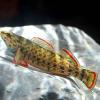This is going to be a little rough until I'm able to borrow a good Macro lens and get some pictures...but...
I've found (at least) two macro parasites on my Darters (Etheostoma spectibile "Orangethroat" and E. flabellare "Fantail" )collected from Spring Creek Oklahoma.
The 1st parasite is an external one on the caudal fin of a decent sized female "Orangethroat". I have been watching it slowly grow since I brought them home. It started out around 3-4mm long and I have watched it gain size until it is now about 5-6mm long. It is has an elongated tubular body, while I can not see segmentation for sure I suspect it is there. It is attached to the caudal peduncle of the fish by what I gather is it's "head". It is slightly fatter at the "head" end and has no visible structure that it is attached by. It has at least one dark line running the length of its body. I believe it is a little itty bitty leach of some kind.
The second parasite is internal and is located under the skin/scales about 3/4 of the way down the side of a smaller "Fantail" Darter. It appears as a 2-3mm round whitish cyst like structure. At first I mistook it for part of the fish's markings, however is best viewed when light passes through the body of the Darter..I suspect this is an encapsulated nematode or other parasitic worm.
My goal for this tank is to have as much bio-diversity as possible, so if these things are not going to cause my fish excessive stress or kill them, I see no reason to "treat" for these critters.
So, anybody have any ideas as to what exactly these parasites are and how their life cycles work and if they are going to be dangerous to my Darters or other fish/inverts?
Extra info: Tank is a 3ft, 45 gallon "tall" with 1-2 watts per gallon lighting. Everything (gravel,wood,plants,etc) in the tank was collected legally from Spring Creek Oklahoma with dip nets or by hand. The tank mimics the stream bed in an eddy of riffle section with some large river gravel (multiple rock types -limestone, flint, shale etc) a few larger rocks some "drift wood", leaf litter and plants that resemble "java moss", camboda and other "aquarium plants" (Sorry, my wife is the one who's into the aquatic plants...I'm still learning). Filtration and flow is accomplished by an Emperor 400 filter and a 4 foot bendable "bubble wall" underneath the river gravel running along the back and sides of the tank. I try to keep the tank temp at 75F or below, but my fish room can get a little warm as my tropical tanks try to keep the room's temp at 80F
Other Fish:
3 Gambusia affinis (I may "destroy" these)
1 Gambusia species that almost looks like a "clear creek" type, but is probably just affinis or a hybrid...I apologize for not having a positive ID on this one.<--I'll split off a topic when I get a good picture...
5 Notropis boops "Big Eye Shiner"
Known Macro Inverts:
5 Orconectes neglectus neglectus Crayfish
At least 2 species of snails
Thoughts, opinions, and feedback on the set-up are welcome.









